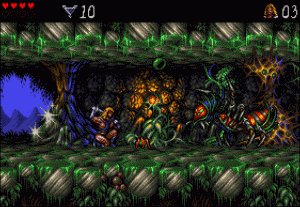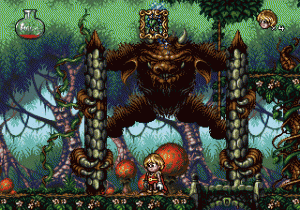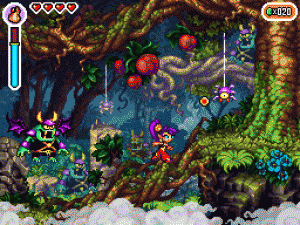 For almost three decades, Henk Nieborg has been creating amazing pixel art. Beginning with 1990’s Ghost Battle for Thalion software back on the Commodore 64, he’s worked on a number of platforms, including the Mega Drive, where he did the beautiful artwork for The Misadventures of Flink in 1994. That game was released on the Mega Drive and Mega CD in Europe and on the Sega CD in the U.S., and gamers in both regions were able to marvel at the lush and detailed art that Nieborg had created. Flink was followed by the Adventures of Lomax in the Playstation and PC, and Nieborg has since gone on to work on multiple consoles. He has done art for games like Spyro: A Hero’s Tale and Contra 4. He has also collaborated with Wayforward to produce pixel art and assets for Shantae 2: Risky’s Revenge on the DS and Shantae 3: The Pirate’s Curse on the 3DS.
For almost three decades, Henk Nieborg has been creating amazing pixel art. Beginning with 1990’s Ghost Battle for Thalion software back on the Commodore 64, he’s worked on a number of platforms, including the Mega Drive, where he did the beautiful artwork for The Misadventures of Flink in 1994. That game was released on the Mega Drive and Mega CD in Europe and on the Sega CD in the U.S., and gamers in both regions were able to marvel at the lush and detailed art that Nieborg had created. Flink was followed by the Adventures of Lomax in the Playstation and PC, and Nieborg has since gone on to work on multiple consoles. He has done art for games like Spyro: A Hero’s Tale and Contra 4. He has also collaborated with Wayforward to produce pixel art and assets for Shantae 2: Risky’s Revenge on the DS and Shantae 3: The Pirate’s Curse on the 3DS.
Sega-16 recently chatted with Mr. Nieborg about his pixel art and his work on The Misadventures of Flink.
Sega-16: How do you get started working on a particular piece? Do you have any particular ritual or habits to get the process started?
Henk Nieborg: I start pixeling on screen immediately after setting the appropriate image resolution and picking the necessary colors. On a background tile set I’ll start with one small piece, objects or ground element in a few colors and build from there. Then, it’s just a matter of time before it actually starts to take shape. From there on, it just flows. I only work from reference that’s given to me by my clients, but if I’m working on my own project it’s just freehand. I also love to look at other artist’s work to get inspired.
Sega-16: Your art style emphasizes great attention to detail. How difficult is this to transfer over to the video games?
 Henk Nieborg: I always had an eye for detail on anything really; it’s just the way I am. So, it’s not difficult for me at all. Everybody has their own style, Mine’s detail. 🙂 It takes no effort, but sometimes it’s hard to stop adding stuff. To find the right balance in your detailing is really important. Adding too much will clutter things up and can start looking messy. I sometimes remove pixels/details and make it work better after not looking at my artwork for some time.
Henk Nieborg: I always had an eye for detail on anything really; it’s just the way I am. So, it’s not difficult for me at all. Everybody has their own style, Mine’s detail. 🙂 It takes no effort, but sometimes it’s hard to stop adding stuff. To find the right balance in your detailing is really important. Adding too much will clutter things up and can start looking messy. I sometimes remove pixels/details and make it work better after not looking at my artwork for some time.
Sega-16: How did the opportunity to work with Psygnosis come about?
Henk Nieborg: The situation at our current employer (Thalion 1992) started to become unstable. Me and Erwin wrote a letter, including a demo disc from Lionheart, to several big companies. Back then, you had to use normal mail to promote yourselves. No sight of internet or email yet. We received an invitation from Psygnosis quite quickly and grabbed it with both hands. On our way to England, me and Erwin wrote a small concept for our next game, Which became Flink. We wanted to develop a game for the Amiga, but Psygnosis gave us the opportunity to develop a game for the Sega Mega Drive. This was unbelievable for us back then. We quit our jobs at Thalion and started working independently from home.
Sega-16: So the Misadventures of Flink was your first console game. How different was this from working on the Amiga?
Henk Nieborg: I really had to scratch my head because that’s a long time ago. 🙂 Alright, The console hardware was designed for action games like Flink. The Amiga had quite a few limitations compared to all the hardware sprites and different background layers you had on the Sega Mega Drive. Music and color palette was loads better on the Amiga, though. It was also a real challenge to get all the graphics in that amount of memory on the Mega Drive. The thing I love about dedicated hardware is that you can really push its limits and beyond, And I think we did. I regret that this was first but also our last game on any 16-bit console. I would have loved to do so much more on a 16-bit console.
Sega-16: Where did you get the inspiration for the characters and setting for Flink?
Henk Nieborg: I’m a huge fan of early ’90s Capcom games in the arcade. The one game that influenced me the most was Capcom’s Three Wonders, Midnight Wanderers: Quest for the Chariot. It’s a platformer with wonderful colors that fascinated me.
Sega-16: Were there ever any plans to do another Mega Drive game if Flink had sold well? What about working on the SNES? It lasted a year longer than the Mega Drive and had the capacity for much richer and colorful visuals.
Henk Nieborg: Actually, I was already doing animations for our next Mega Drive game after Flink before we realised that the Mega Drive was kind of given up by publishers. I made a few Lemming characters that ran and jump around, and everybody liked it. This became Lomax later. Unfortunately, The SNES was never an issue for Psygnosis but I would have loved to do something for it back then. It sadly never happened.
Sega-16: Flink didn’t sell particularly well due to under marketing during the change in hardware cycles and the move to 3D. Were you surprised then that Psygnosis asked you to work on The Adventures of Lomax?
 Henk Nieborg: Lomax was already under development for the Mega Drive, but we swapped to the Playstation very soon after that. That was a very exciting time to develop for a new piece of powerful hardware. Lomax was supposed to be big and the next Lemmings spin-off. There were even plans for a TV animation series. I actualy saw the concept art for that. Lomax was just one of the eight planned characters that appeared in the game and series. Unfortunately the project was shortened by Psygnosis because we probably didn’t deliver what the marketing department had in mind. Lomax could have been lots bigger and a Playstation first release game but me and Erwin were kind of distracted by other things in life. We really had no clue looking back at it now. We just wanted to make a great game.
Henk Nieborg: Lomax was already under development for the Mega Drive, but we swapped to the Playstation very soon after that. That was a very exciting time to develop for a new piece of powerful hardware. Lomax was supposed to be big and the next Lemmings spin-off. There were even plans for a TV animation series. I actualy saw the concept art for that. Lomax was just one of the eight planned characters that appeared in the game and series. Unfortunately the project was shortened by Psygnosis because we probably didn’t deliver what the marketing department had in mind. Lomax could have been lots bigger and a Playstation first release game but me and Erwin were kind of distracted by other things in life. We really had no clue looking back at it now. We just wanted to make a great game.
Sega-16: Was there ever any publisher resistance to Lomax due to it being a 2D pixel art game?
Henk Nieborg: No, Everybody loved it at Psygnosis when it started taking shape. Only the press couldn’t care less. We also didn’t get much exposure as other teams at Psygnosis got, but that’s not our fault. If only Mickey Mouse would have starred in Lomax, Just saying… 😛
Sega-16: Lomax was reportedly going to have a sequel, but it was canceled? What happened, and how far along was it when it was dropped?
Henk Nieborg: Right after Lomax, we made plans for another game for the PlayStation and wrote a complete “epic” design document including lots of artwork. So, not really a sequel to Lomax. It had quite a budget, I can tell you. Then everything went bad at Sony/Psynosis and all 3rd party developers were being dismissed. We were on our own all of a sudden, which came quite as a shock. We never really recovered from that, and we all went our own ways.
Sega-16: People seem to be coming back to the charm of pixel art, as evidenced by the immense sales of 2D games on platforms like Steam and the Nintendo 3DS. Do you think pixel art games can still sell well in retail channels alongside modern games, or are they going to be relegated to portable game systems and download services only from now on?
Henk Nieborg: When pixel art is done, right it’s timeless. It’s great to see all those small indie games, but there are only a few good ones among them that include real quality pixels. If it were up to me, I would love to see a pixel game on the store shelves again. Holding your newly purchased game in your hands is a lot better experience then just downloading it. Lots of youngsters probably don’t understand this, but I’m just old fashioned, I think. Having a real product in your hands is still a much better deal, in my honest opinion, but it’s cheaper and easier not to. It works both ways. That’s why I still love the SNES and Mega Drive. They created collectible treasures, something you can’t do with downloads.
 Anyway, I’m really happy to see that the appreciation for quality pixels is back. It also kept me going. I would had never thought that 25 years later I would still be doing new pixels. I’m very thankful for the appreciation I got over the years. I’m still cooking on my own insane pixel action project over here. I’m not sure yet if I’m going the crowdfund way, but we’ll see. 😉
Anyway, I’m really happy to see that the appreciation for quality pixels is back. It also kept me going. I would had never thought that 25 years later I would still be doing new pixels. I’m very thankful for the appreciation I got over the years. I’m still cooking on my own insane pixel action project over here. I’m not sure yet if I’m going the crowdfund way, but we’ll see. 😉
Sega-16: Thanks for the interview. It was great talking about wonderful pixel art!
Henk Nieborg: You’re welcome, Always nice to look back on your career. Cheers!
Our thanks to Mr. Nieborg for taking the time for this interview. To view more of his work, be sure to check out his website.

Pingback: Lionheart (EU) (1993) (Action Platform) (Amiga) – Johnny Game Over MAG